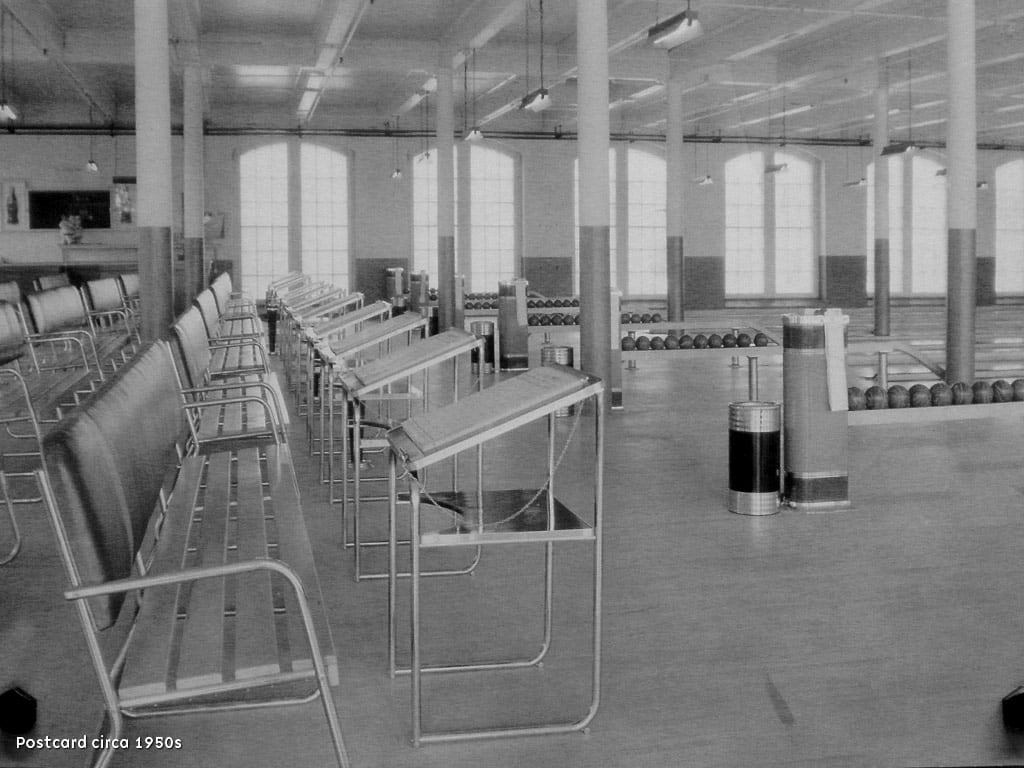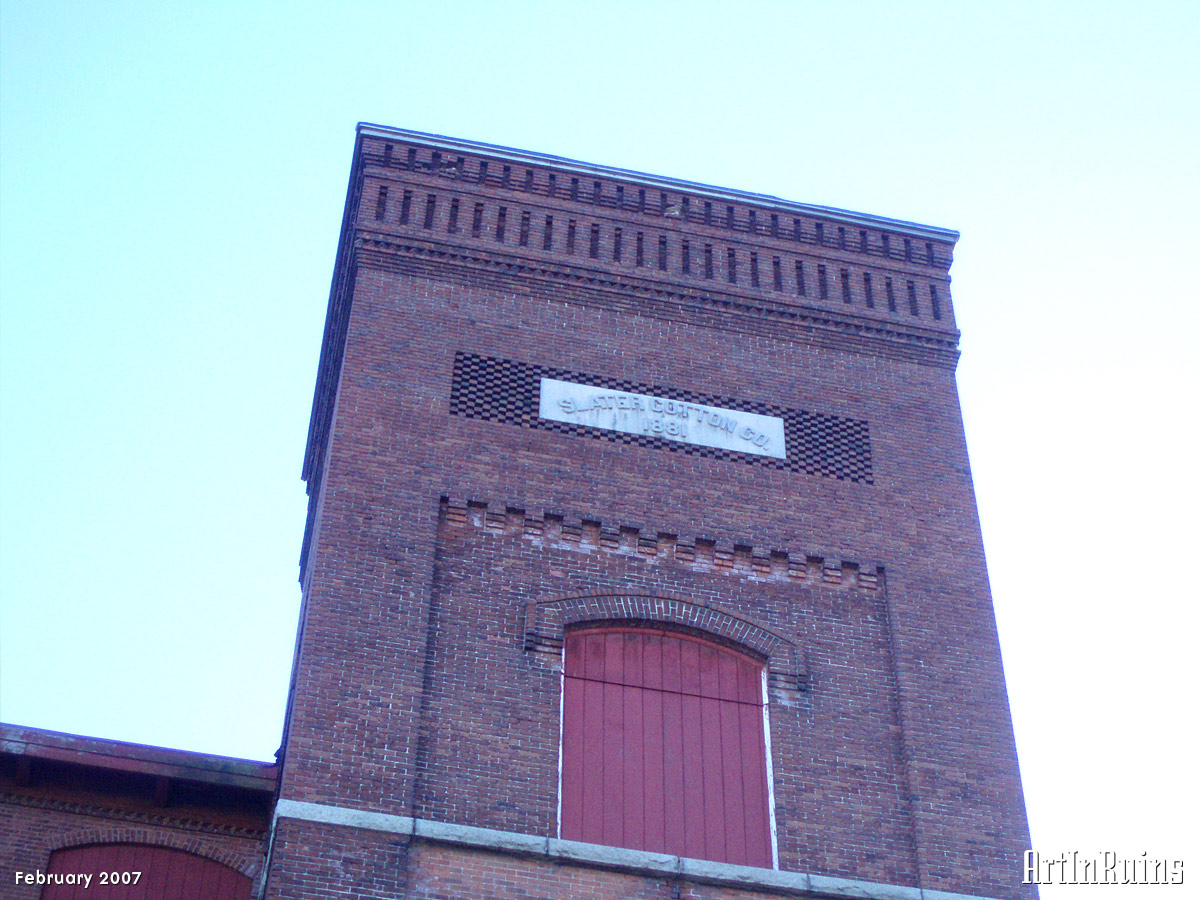Slater Cotton
A tall, handsome mill which was a cottom weaving company for about 35 years before becomming a realty company that rented space to other businesses — now residential lofts
images of this Property
-

Bowling Alley photo and postcard from hallway display. “Hamlet 30 Lanes”, with a postmark from 1957: “One of New England’s largest and finest duckpin bowling centers. Site of 1955 record-breaking National Tournament.” -

Bowling Alley photo and postcard from hallway display. Hamlet 30 Lanes was apparently a tenant in the building. -

Photo by Warren Jagger 1982 -

-
![]()
-
![]()
-
![]()
-
![]()
-
![]()
-
![]()
-
![]()
-
![]()
-
![]()
-
![]()
-
![]()
-
![]()
-
![]()
-
![]()
-
![]()
-
![]()
-
![]()
-
![]()
-
![]()
-
![]()
-
![]()
25 images: Press to view larger or scroll sideways to see more. Contribution by Warren Jagger for the National Register nomination form, Church Hill Industrial District
About this Property
Redevelopment
New Hampshire-based Brady Sullivan Properties purchased the former Slater Cotton Mill in 2007 or 2008. The downtown property is the second historic Rhode Island mill the developer acquired in six months — the first being Carpenter Mills, aka Grant’s Mill, on the West Side of Providence. Brady Sullivan spent $22 million to renovate the 164,175-square-foot mill and created 124 market-rate loft condominiums which opened in 2009.
Current Events
Rental information is available at slatercottonmill.com. The units all have high ceilings and large mill windows with shared spaces including a fitness center, rooftop patio, and movie theatre.
History
From the Church Hill Industrial District nomination form, 1982
Constructed by B.F. Smith and Company, the Slater Cotton Company Mill is a long, flat-roofed, 3- and 4-story red brick mill, built on a high granite foundation, with a large 2-story weave shed adjoining its southeast corner. The main 4-story mill runs parallel to Church Street; the 3-story section is at the south side.
Two handsome mill towers are located on the north side — their hipped roofs have been replaced by flat ones, but they retain their patterned brick cornices and freight doors. Granite courses separate the stories of the building. The windows have segmental-arch heads with paired, double-hung, 9-over-9 sash and, while many of the window openings are boarded over, most retain their original sash. A cast-iron fence apparently dating from the nineteenth-century runs along the north street side of the main mill.
The brick and wooden weave shed has a saw-tooth roof designed to provide soft northern light to the interior. The fenestration of the weave shed matches that of the main mill. Attached to the northeast corner of the main mill is a small, 2-story, brick section.
New freight door openings have been cut into the weave shed and a new entrance has been added to the west end of the main mill to accommodate modern industrial and commercial requirements but, as a whole, the Slater Cotton Company Mill is well-preserved and in good condition.
From “RHODE ISLAND: An Inventory of Historic Engineering and Industrial Sites”, Gary Kulik and Julia C. Bonham, 1978
This company began producing twills, sateens, and fine quality bleached cotton cloth in 1869 in a 21⁄2-story, brick, pitched-roof building, 300’ X SO’, built in l863 and originally used as a file factory. This structure remains and, with its multiple ells, covers a city block directly north-of the main building, a 5-story, brick mill, 340’ X 92’, built in 1881-1882. This imposing structure, with its twin end towers, slightly pitched-roof and fine brick dentils contained 1,475 looms in 1891 and employed 600 workers. Both towers were originally built with peaked hipped roofs now removed.
During the late 19th century, the company produced four million yards of cloth annually with some of the best machinery available — Whitin revolving flat cards, Howard Bullough electric drawing frames, Carter combers, Fales Jenks spinning frames, and Whitin looms. Each room was equipped with patent automatic sprinklers, and the weave room contained a German-patent Aerophor air moistening machine. The old mill was powered by a 325-horsepower Corliss engine and was lighted electrically by the Waterhouse arc system. The new mill was powered by a 600-horsepower Harris-Corliss and a 250-horsepower Greene engine and, by 1891, was lighted by the Edison incandescent system, a relatively early factory use of Edison’s new electrical system. No historic machinery survives.
Credit: Grieve; Interview with owner of 1881 mill, Joseph Sousa, Slater Realty Company, August, 1975.
William P. Sayles
From the RI Historical Society collection of Business records, 1868-1918
Mr. Sayles was one of a number of prominent Rhode Island businessmen who founded the Slater Cotton Company in Pawtucket in November 1868. At the outset, Sayles was not particularly prominent in the company’s affairs, owning only 300 our of 4,000 shares outstanding and holding no company office. By January 1881, however, William F. Sayles owned a majority of the company’s stock, which remained widely distributed throughout the 19th century.
The Slater Cotton Company manufactured cotton goods in the grey state, which it either sold directly to commission merchants or contracted to be finished at nearby bleacheries or dye works. It also manufactured large quantities of cotton yarn which it sold, for the most part, to other cotton mills. By 1900, its product line included “Pride of the West” muslins, twills, sateens, nainsooks, and fancy lenos, as well as fine cotton yarns. The plant consisted of the Main Street Pawtucket factory of the American File Company, acquired in 1868, and a large brick mill on Church Street, erected in 1872.
The Slater Cotton Company apparently fared poorly in the first decade of the 20th century. By October 1908, it had fallen so deeply in debt that it was reorganized as a new corporation, the Slater Manufacturing Company. At this time, its functions were broadened to include manufacturing of silk cloth. This move failed to halt the company’s downward slide, which led to the liquidation of its manufacturing activities in 1915. In February 1915, its silk department was sold to the Hamlet Textile Company’s Pawtucket department (another Sayles holding), and in October 1915, its cotton yard department was sold to form the Slater Yarn Company (also called Sayles). For the next few years, the Slater Manufacturing Company existed solely as a real estate holding company, renting space in its Pawtucket plant to the Hamlet Textile Company. December 1918 saw the final closing of the Slater Manufacturing Company’s books.




















